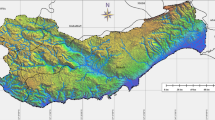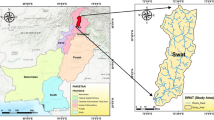Abstract
Loess Plateau is one of the ecologically fragile regions in China. It is one of the slippery strata of which landslides often developed. The formation and development of landslides are mainly affected by various natural environments, triggering factors, the vulnerability of landslide-bearing bodies, and topography has a controlling effect on landslides and determines landslide distribution. As important environmental elements, the selection and reclassification of topographic factors are the basis for loess landslide vulnerability map. In this study, our research suggests an effective workflow to select and analyze the topographic factors in the loess landslides. Nine hazard-formative environmental factors [e.g., slope, aspect, slope shape (SS), slope of slope (SOS), slope of aspect (SOA), surface amplitude (SA), surface roughness (SR), incision depth (ID) and elevation variation coefficient (EVC)] are prepared for landslide suitability analysis. The models of certainty factor, sensitivity index and correlation coefficient are combined to select and analyze the suitability of these factors. Four topographic factors (i.e., slope, SOS, SS and SR) were ultimately selected to carry out the landslide vulnerability mapping with other factors. Our results showed that most of the landslides were located in medium and high classes and accounting for 75.3%, and these places also coincided with higher economies and intense human activities. Our research also suggested that in situ measurements are necessary to determine how to reclassify these topographic factors and how many grades these topographic factors divided, which would further improve the reliability of landslide vulnerability map for the decision makers to deal with the possible future landslides in terms of safety and human activities.






Similar content being viewed by others
References
Akgun A, Erkan O (2016) Landslide susceptibility mapping by geographical information system-based multivariate statistical and deterministic models: in an artificial reservoir area at Northern Turkey. Arab J Geosci 9:165
Alexoudi MN, Manolopoulou SB, Papaliangas T, Patronis C (2011) Landslide risk assessment and management of the Florina–Pisoderi–Kastoria roadline (Greece). J Environ Prot Ecol 12:114–124
Ayalew L, Yamagishi H, Ugawa N (2004) Landslide susceptibility mapping using GIS-based weighted linear combination, the case in Tsugawa area of Agano River, Niigata Prefecture, Japan. Landslides 1:73–81
Cai QG, Lu ZX, Wang GP (1996) Process-based soil erosion and sediment yield model in a small basin in the hilly loess region. Acta Geogr Sin 51:108–117
Conforti M, Pascale S, Sdao F (2015) Mass movements inventory map of the Rubbio stream catchment (Basilicata—South Italy). J Maps 11:454–463
Duan Y (1993) Geo-hazards in China (1st version. China Construction Industry Press, Beijing
Einstein (1988) Special lecture: landslide risk assessment procedure. In: Proceedings of 5th international symposium on landslides. Lausanne, vol 2, pp 1075–1090
Erener A, Düzgün HSB (2011) Landslide susceptibility assessment: what are the effects of mapping unit and mapping method? Environ Earth Sci 66:859–877
Fenton GA, McLean A, Nadim F, Griffiths DV (2013) Landslide hazard assessment using digital elevation models. Can Geotech J 50:620–631
Fourniadis IG, Liu JG, Mason PJ (2007) Landslide hazard assessment in the Three Gorges area, China, using ASTER imagery: Wushan–Badong. Geomorphology 84:126–144
Grozavu A, Margarint MC, Patriche CV (2012) Landslide susceptibility assessment in the Braiesti–Sinesti Sector of Iasi Cuesta. Carpathian J Earth Environ Sci 7:39–46
Guzzetti F, Reichenbach P, Ardizonne F, Cardinali M, Galli M (2009) Landslide hazard assessment, vulnerability estimation and risk evaluation: an example from the Collazzone Area (Central Umbria, Italy). Geogr Fis Din Quat 32:183–192
Heckerman D (1986) Probabilistic interpretations for MYCIN’s certainty factors. In: Kanal L, Lemmer J (eds) Uncertainty in artificial intelligence. North-Holland, New York, pp 167–196
Heckerman D (2013) Probabilistic interpretations for Mycin’s certainty factors. Mach Intell Pattern Recognit 4:167–196
Jiang S, Tang G, Liu K (2015) A new extraction method of loess shoulder-line based on Marr–Hildreth operator and terrain mask. PLoS ONE 10:e0123804
Jimenez-Peralvarez D, El Hamdouni R, Palenzuela JA, Irigaray C, Chacon J (2017) Landslide-hazard mapping through multi-technique activity assessment: an example from the Betic Cordillera (southern Spain). Landslides 14:1975–1991
Johnson K, Depietri Y, Breil M (2016) Multi-hazard risk assessment of two Hong Kong districts. Int J Disaster Risk Reduct 19:311–323
Lan H, Wu F, Zhou C, Wang S (2002) Analysis on susceptibility of GIS based landslide triggering factors in Yunnan Xiaojiang watershed. Chin J Rock Mech Eng 21:1500–1506
Lee S (2005) Application of logistic regression model and its validation for landslide susceptibility mapping using GIS and remote sensing data journals. Int J Remote Sens 26:1477–1491
Liu DS (2009) Loess and dry environment. Anhui Science and Technology Publishing House, Hefei
Liu K, Tang GA, Jiang LM, Zhu AX, Yang JY, Song XD (2015) Regional-scale calculation of the LS factor using parallel processing. Comput Geosci 78:110–122
Lv GN, Qian YD, Chen ZM (1998) Study of automated mapping of channel network in hilly loess region. Acta Geod Cartogr Sin 27:131–137
Ma S, Li H, Zhang Y, Li J (2016) The Neogene extension of the Tianshui basin: evidence from sedimentary and structural records. Geol Bull China 35:1314–1323
Moon V, Blackstock H (2004) A methodology for assessing landslide hazard using deterministic stability models. Nat Hazards 32:111–134
Niu Q, Cheng W, Liu Y, Xie Y, Lan H, Cao Y (2012) Risk assessment of secondary geological disasters induced by the Yushu earthquake. J Mt Sci 9:232–242
Parry S (2016) Landslide hazard assessments: problems and limitations. Examples from Hong Kong. Geol Soc Lond Eng Geol Spec Publ 27:135–145
Shortliffe E, Buchanan B (1975) A model of inexact reasoning in medicine. Math Biosci 23:351–379
Song X, Tang G, Li F, Jiang L, Zhou Y, Qian K (2013) Extraction of loess shoulder-line based on the parallel GVF snake model in the loess hilly area of China. Comput Geosci 52:11–20
Sun W, Tian Y, Mu X, Zhai J, Gao P, Zhao G (2017) Loess landslide inventory map based on GF-1 satellite imagery. Remote Sens 9:314
Tang C (2000) Characteristics of landslides and its hazard assessment in boon area. Ger J Soil Water Conserv 14:48–53
Tang G, Liu X (2006) Digital elevation model and principle and methodology in geographical analysis. Science Press, Beijing
Tang G, Song X, Li F, Zhang Y, Xiong L (2015) Slope spectrum critical area and its spatial variation in the Loess Plateau of China. J Geogr Sci 25:1452–1466
Tien Bui D, Pradhan B, Lofman O, Revhaug I (2012) Landslide susceptibility assessment in Vietnam using support vector machines, decision tree, and Naïve Bayes Models. Math Probl Eng 2012:1–26
Varnes DJ (1984) Landslide hazard zonation: a review of principles and practice. UNESCO, Paris
Wu W, Wang N (2006) Gansu landslide hazard. Lanzhou University Press, Lanzhou
Xiong LY, Tang GA, Li FY, Yuan BY, Lu ZC (2014) Modeling the evolution of loess-covered landforms in the Loess Plateau of China using a DEM of underground bedrock surface. Geomorphology 209:18–26
Xu L, Dai FC, Kwong AKL (2009) Analysis of some special engineering-geological problems of loess landslide. Chin J Geotech Eng 31:287–293
Xu C, Dai F, Yao X, Chen J et al (2010) GIS based certainty factor analysis of landslide triggering factors in Wenchuan earthquake. Chin J Rock Mech Eng s1:642–664
Zezere JL, Pereira S, Melo R, Oliveira SC, Garcia RAC (2017) Mapping landslide susceptibility using data-driven methods. Sci Total Environ 589:250–267
Zhang M, Liu J (2009) Controlling factors of loess landslides in western China. Environ Earth Sci 59:1671–1680
Zhang JQ, Cui P, Ge YG, Xiang LZ (2012) Susceptibility and risk assessment of earthquake-induced landslides based on Landslide Response Units in the Subao River basin, China. Environ Earth Sci 65:1037–1047
Zhang M, Cao XL, Peng L, Niu RQ (2016) Landslide susceptibility mapping based on global and local logistic regression models in Three Gorges Reservoir area, China. Environ Earth Sci 75:958
Zhou JX, Zhu CY (2002) Landslide disaster in the loess of China. J For Res 13:157–161
Zhu SJ, Tang GA, Xiong LY, Zhang G (2014) Uncertainty of slope length derived from digital elevation models of the Loess Plateau, China. J Mt Sci 11:1169–1181
Zhuang JQ, Peng JB (2014) A coupled slope cutting-a prolonged rainfall-induced loess landslide: a 17 October 2011 case study. Bull Eng Geol Environ 73:997–1011
Acknowledgements
This research was supported by the National Natural Science Foundation of China (41461084), the Natural Science Foundation of Gansu Province (145RJZA180). We also thank the Gansu Administration of Surveying, Mapping and Geo-information of China for the provision of DEM data.
Author information
Authors and Affiliations
Corresponding author
Rights and permissions
About this article
Cite this article
Niu, Q., Dang, X., Li, Y. et al. Suitability analysis for topographic factors in loess landslide research: a case study of Gangu County, China. Environ Earth Sci 77, 294 (2018). https://doi.org/10.1007/s12665-018-7462-y
Received:
Accepted:
Published:
DOI: https://doi.org/10.1007/s12665-018-7462-y




